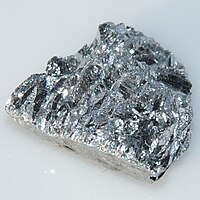
Photo from wikipedia
Objectives The US National Toxicology Program (NTP) recently recommended in its Report on Carcinogens Monograph for Antimony Trioxide that antimony trioxide be listed as ‘reasonably anticipated to be a human… Click to show full abstract
Objectives The US National Toxicology Program (NTP) recently recommended in its Report on Carcinogens Monograph for Antimony Trioxide that antimony trioxide be listed as ‘reasonably anticipated to be a human carcinogen’ based on sufficient evidence of carcinogenicity in experimental animals and supporting evidence from mechanistic studies. Our goal was to estimate the possible human cancer risk from occupational exposure to antimony trioxide. Methods We selected data from 2-year inhalation studies in male and female mice conducted by the NTP and performed cancer dose–response analyses using cancer models and benchmark dose methods developed by the US Environmental Protection Agency. In these analyses, we generated benchmark doses and cancer slope factors for antimony trioxide, and then estimated human cancer risk under various exposure scenarios. Typical and worst-case inhalation scenarios in multiple occupational settings were used in risk estimation. Results In typical case scenarios, the occupational cancer risk from antimony trioxide was estimated to be 0.025 (25 in 1000) for persons working with flame retardants in plastics and textiles for 40 years. Under worst-case scenarios, the occupational cancer risk was estimated to be 0.11 (110 in 1000) for persons working with flame retardants in plastics and textiles. At the current Occupational Safety and Health Administration Permissible Exposure Limit, the cancer risk for occupational inhalation exposure of antimony trioxide was estimated to be 0.096 (96 in 1000). Conclusion The risk estimates calculated in this study suggest that exposure to antimony trioxide at levels present in certain occupational settings results in a large increase in the risk of developing cancer.
Journal Title: Occupational and Environmental Medicine
Year Published: 2020
Link to full text (if available)
Share on Social Media: Sign Up to like & get
recommendations!